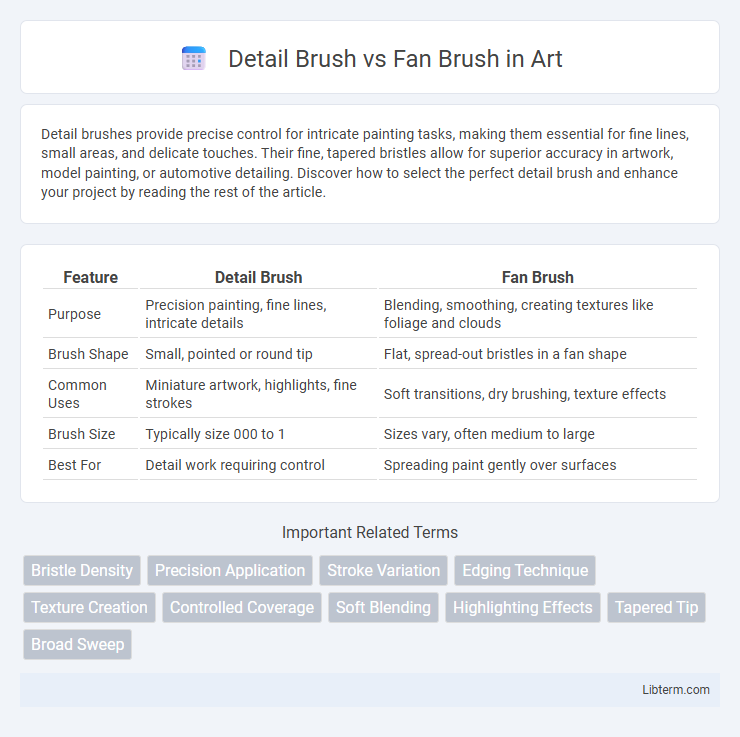Detail brushes provide precise control for intricate painting tasks, making them essential for fine lines, small areas, and delicate touches. Their fine, tapered bristles allow for superior accuracy in artwork, model painting, or automotive detailing. Discover how to select the perfect detail brush and enhance your project by reading the rest of the article.
Table of Comparison
| Feature | Detail Brush | Fan Brush |
|---|---|---|
| Purpose | Precision painting, fine lines, intricate details | Blending, smoothing, creating textures like foliage and clouds |
| Brush Shape | Small, pointed or round tip | Flat, spread-out bristles in a fan shape |
| Common Uses | Miniature artwork, highlights, fine strokes | Soft transitions, dry brushing, texture effects |
| Brush Size | Typically size 000 to 1 | Sizes vary, often medium to large |
| Best For | Detail work requiring control | Spreading paint gently over surfaces |
Introduction: Detail Brush vs Fan Brush
Detail brushes feature fine, pointed bristles designed for precision work and intricate lines, making them ideal for adding small highlights and delicate details in artwork. Fan brushes have spread-out bristles that create texture and soft blending effects, perfect for painting foliage, clouds, or subtle gradients. Choosing between a detail brush and fan brush depends on the desired effect, whether it's fine detail or broad textural strokes.
Understanding Brush Shapes and Functions
Detail brushes feature fine, pointed bristles ideal for precise lines, intricate patterns, and delicate touches in painting, making them essential for adding texture and small highlights. Fan brushes, characterized by their spread-out bristles, excel at blending, creating soft edges, and producing natural effects such as foliage, clouds, and textures in landscapes. Understanding these brush shapes enhances technique selection, ensuring artists achieve desired effects and maintain control over their artwork's detail and softness.
Detail Brush: Key Features
Detail brushes feature fine, pointed bristles designed for precision work, making them ideal for intricate lines, small highlights, and delicate textures. These brushes typically have a small diameter with tightly packed synthetic or natural hairs that offer excellent control and accuracy. Compared to fan brushes, detail brushes excel in detailed artwork requiring meticulous strokes and refined edges.
Fan Brush: Key Features
Fan brushes feature a flat, spread-out shape with long, thin bristles that create soft, textured strokes ideal for blending and smoothing. They excel in painting natural elements like grass, foliage, and clouds due to their ability to produce varied, organic patterns. Unlike detail brushes with fine points for precision, fan brushes are designed for broader, expressive effects in both acrylic and oil painting techniques.
Best Uses for Detail Brushes
Detail brushes excel in precision work, making them ideal for intricate designs, fine lines, and delicate textures in painting. Their small, pointed tips allow artists to add highlights, small details, and intricate patterns with accuracy that larger brushes cannot achieve. Best used for miniature art, portrait highlights, and detailed touch-ups, detail brushes are essential tools for refining artwork.
Best Uses for Fan Brushes
Fan brushes excel in blending and softening edges, making them ideal for creating textures in landscapes such as foliage, grass, and clouds. Their spread-out bristles allow artists to achieve subtle gradients and feathered effects that detail brushes cannot replicate. While detail brushes focus on precision and fine lines, fan brushes provide versatility in sweeping, broad strokes for naturalistic background elements.
Comparing Detail and Fan Brushes in Practice
Detail brushes offer precise control for intricate work like fine lines and small highlights, while fan brushes excel in creating textures such as foliage, clouds, or soft blending effects. Detail brushes generally have tightly packed, fine bristles ideal for accuracy, whereas fan brushes feature spread-out bristles that allow for broader, more diffuse strokes. Artists often choose detail brushes for precision and fan brushes for expressive textural elements in various painting techniques.
Tips for Choosing the Right Brush
When choosing between a detail brush and a fan brush, consider the precision and texture needed; detail brushes offer fine, controlled strokes ideal for intricate work, while fan brushes excel at blending and creating soft edges. Selecting the right brush depends on the medium and project scale, with synthetic fibers preferred for acrylics and natural hairs for oils. Prioritize brush shape, stiffness, and bristle length to match your painting technique and desired effects effectively.
Common Mistakes with Each Brush
Detail brushes are often misused by applying excessive pressure, causing bristle fraying and loss of precision in fine lines. Fan brushes commonly suffer from improper cleaning, leading to splayed bristles and uneven paint application. Both brushes require proper handling and maintenance to maintain their intended shape and functionality for optimal artistic results.
Final Verdict: Which Brush to Choose?
The Detail Brush is ideal for precise, intricate work like fine lines and delicate highlights, providing controlled strokes and accuracy. The Fan Brush excels in blending, texturing, and creating soft, natural effects such as foliage or clouds, offering wider coverage with optimal softness. Choose the Detail Brush for precision tasks and the Fan Brush for broader, textured applications to enhance your painting technique efficiently.
Detail Brush Infographic

 libterm.com
libterm.com